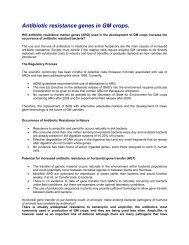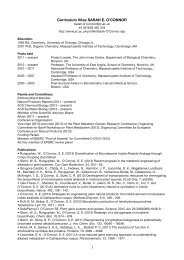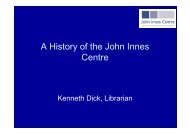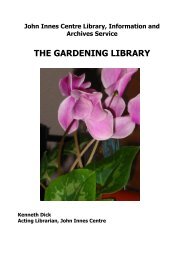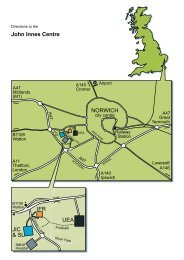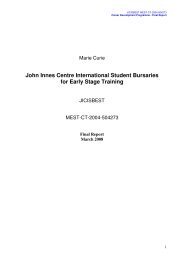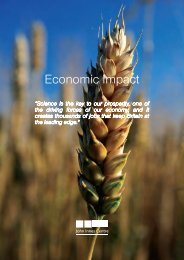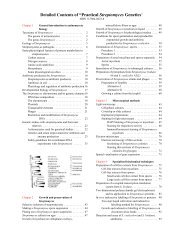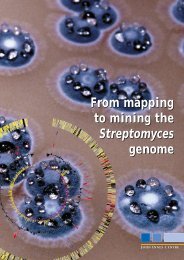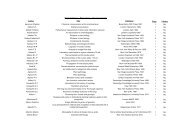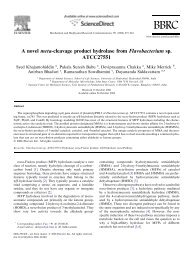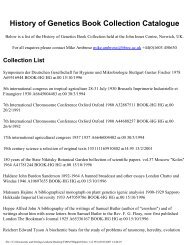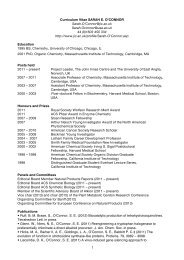1910s Timeline - John Innes Centre
1910s Timeline - John Innes Centre
1910s Timeline - John Innes Centre
Create successful ePaper yourself
Turn your PDF publications into a flip-book with our unique Google optimized e-Paper software.
1913 A. H. Sturtevant produces<br />
the first Genetic Map in<br />
Drosophila<br />
Alfred Sturtevant, an<br />
undergraduate working with<br />
Morgan at Columbia, provides the<br />
experimental basis for the linkage<br />
concept in Drosophila and devises a<br />
visual representation or ‘map’ to<br />
show the links<br />
1913-14 Nikolai Vavilov joins the<br />
JIHI as Visiting Researcher<br />
Nikolai Vavilov, a recent graduate<br />
of the Moscow Agricultural<br />
Institute, and on an official tour of<br />
the main biological laboratories of<br />
Western Europe, arrives at the JIHI<br />
with an established interest in plant<br />
selection and the work of Gregor<br />
Mendel. He is deeply impressed<br />
with Bateson, both as a scientist<br />
and as a democratic administrator<br />
who allowed his staff great<br />
freedom to pursue their individual<br />
scientific ideas and experiments.<br />
Vavilov completes his postgraduate<br />
thesis at JIHI which entitles him to<br />
become a professor on his return to<br />
Russia. In 1917 he became a<br />
professor at Saratov University,<br />
south-east of Moscow and in 1921<br />
moved to head the Applied Biology<br />
Branch at Petrograd (St<br />
Petersburg). From these<br />
beginnings he built up the All-<br />
Union Institute of Plant Breeding,<br />
one of the world’s most<br />
distinguished centres of research in<br />
plant selection and genetics.<br />
1914 Bateson is President of the<br />
British Association in Australia<br />
Bateson leaves for Australia in June<br />
to preside over the British<br />
Association meeting; he returns in<br />
November. Extracts of Bateson’s<br />
lectures on the mechanisms of<br />
inheritance and on eugenic themes<br />
at the Melbourne and Sydney<br />
meetings are published in The<br />
Times and in the American press<br />
where they arouse interest and<br />
opposition. Bateson continues to<br />
deny chromosome theory. T H<br />
Morgan responds ‘We ourselves are<br />
going to get after you soon in a<br />
small book we are writing on ‘The<br />
Mechanism of Mendelian Heredity’<br />
1914-1918 World War I<br />
The war of 1914-1918 curtails the<br />
work of the Institution. By<br />
September 1915 Bateson has<br />
already lost from his scientific staff<br />
G. O. Sherrard (self-sterility in fruit<br />
trees); J. W. Lesley (potato<br />
breeding); M.A. Bailey (plant<br />
pathology); C. B. Williams<br />
(entomology), and C. W.<br />
Richardson (strawberry breeding)<br />
to the war effort. Many of the<br />
garden staff have also left for the<br />
army or for munitions work. Those<br />
that remain are having difficulty<br />
making ends meet as inflation<br />
spirals; they successfully agitate for<br />
an increase in wages. By 1916 the<br />
Board of Agriculture is encouraging<br />
the Institution to use space not<br />
required for experiments to grow<br />
vegetables. About 20,000 seedling<br />
vegetables are raised and<br />
distributed free to local allotmentholders.<br />
In 1917 only three research<br />
workers remain. Many do not<br />
return: the workers not lost to the<br />
war are lost to the Empire.<br />
After the war Bateson recruits new<br />
staff and enlarges the premises by<br />
adding two larger laboratories and<br />
a library.<br />
1915 T H Morgan and his<br />
colleagues publish Mechanism of<br />
Mendelian Heredity<br />
Morgan’s team offer a<br />
comprehensive chromosomal<br />
interpretation of heredity. They<br />
teach that the determinants of the<br />
hereditary characters are the genes<br />
which are resident in the<br />
chromosomes, each gene having its<br />
own particular place or locus in a<br />
particular chromosome<br />
Page 4 of 91



